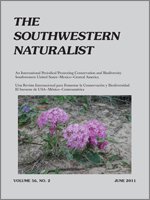We investigated diet of cougars (Puma concolor) in the eastern Sierra Nevada, California, following a decline in the population of mule deer (Odocoileus hemionus). Mule deer declined 84% from 1985 to 1991, a period concurrent with declines in bighorn sheep (Ovis canadensis sierrae; an endangered taxon). An index to numbers of cougars lagged behind those declines, with a reduction of ca. 50% during 1992–1996. We determined diet of cougars by analysis of fecal samples collected during 1991–1995, when the population of mule deer was <25% of its former size. Mule deer was in 79% of 178 feces in winter and 58% of 74 feces in summer. Although most (69%) fecal samples in winter were <5 km from, or within (25%) winter range of bighorn sheep, none contained evidence of bighorn sheep. One fecal sample in summer contained remains of bighorn sheep, indicating that those ungulates were not an important component of the diet during our investigation.
How to translate text using browser tools
1 June 2011
Diet of Cougars (Puma concolor) Following a Decline in a Population of Mule Deer (Odocoileus hemionus): Lack of Evidence for Switching Prey
Jeffrey T. Villepique,
Becky M. Pierce,
Vernon C. Bleich,
R. Terry Bowyer
ACCESS THE FULL ARTICLE

The Southwestern Naturalist
Vol. 56 • No. 2
June 2011
Vol. 56 • No. 2
June 2011




